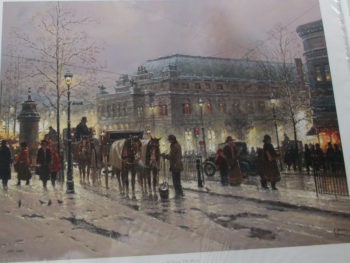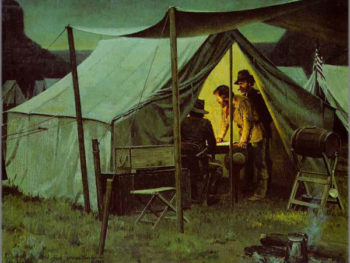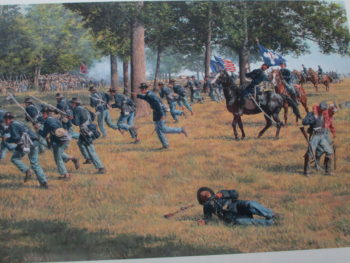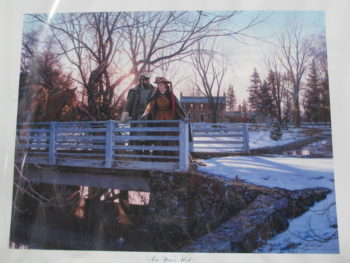Description
[vc_row][vc_column][vc_column_text]Mort Künstler’s Comments:
In 1989, I painted The Grand Review which showed J.E.B. Stuart and his entourage at Brandy Station, Virginia on June 5, 1863. I closed my comments for that painting by saying that after the review, Stuart and his aides went back to Culpeper for an evening ball. After completing the painting, I wanted to paint the ball scene and finally, after ten years, I’ve brought it to fruition. I found out from Culpeper historian Clark B. Hall, that there were actually two balls not just one. The night before the Grand Review there was another ball, and that is the one I decided to depict.
In this painting, Candlelight and Roses, I tried to capture the glamour and pageantry and none of the dark side of the Civil War. It took place on June 4, 1863, in the Culpeper Town Hall. The building no longer exists, having been torn down shortly after the war. However, I learned of various details from architectural historian Maral Kalbian about buildings at that time. The stenciled black and red checkered pattern was typical of the decoration of a building of this type.
General Stuart is the center of attention as he enters, plumed hat in hand, and his wife Flora on his arm. All the young women are bedazzled at the appearance of the famous general as he is greeted by the Honorable John Pendleton, one of the leading citizens of Culpeper. Other couples continue to dance, still unaware of the arrival of the famed cavalry commander.
The decorations of flags, flowers, and bunting are described in a number of accounts and gave me a chance to use the bright colors of the flags and gowns combined with the soft candlelight. The flags are from the four states comprising Stuart’s Cavalry Division at the time – Georgia, North Carolina, South Carolina, and Virginia. Both the 1st and 2nd National flags are also present as the 2nd flag was adopted on May 1, 1863, little more than a month before the ball, hardly enough time to have produced and changed all the national flags of the Army of Northern Virginia.
On the extreme left, hands behind him, is Col. Pierce M.B. Young, Commander of the Cobbs Legion. Gen. Wade Hampton, in the left foreground, is dancing with a young admirer. His sword is quite distinctive and was based on a picture in an 1899 book by Edward L. Wells, who knew Hampton and served under him. We see an assortment of other officers from the infantry, artillery and medical corps as well as cavalry. The tallest and most noticeable officer, marked by the yellow trim on his uniform, is the 6′ 4″ aide to Stuart, Maj. Heros von Borcke, directly in the back of Stuart. Immediately behind von Borcke is Capt. John Esten Cooke, also of Stuart’s staff. Moving further to the right in the far background, behind the Lieutenant holding one glove, is the mustachioed Capt. William Downs Farley, Stuart’s most trusted scout. Farley would be killed five days later in action near Mountain Run. Dancing with the lady in the green gown, in the right foreground, is General Fitzhugh Lee, the nephew of Robert E. Lee and another of Stuart’s Field Commanders.
The ball would be a colorful moment of peaceful pageantry that would cast an aura of invincibility on Stuart’s Cavalry Division. Several days later on June 9, 1863, at the Battle of Brandy Station, this aura would come to an end and the realization of a fierce and bloody war would take over. [/vc_column_text][/vc_column][/vc_row]




